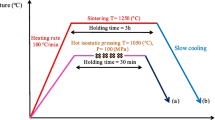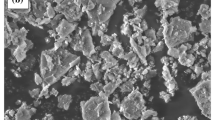Abstract
A series of Zr63.5−xTixAl9Fe4.5Cu23 (x = 0, 1.5, 3.0, 4.5, 6.0; at%) bulk metallic glasses (BMGs) were designed and produced by means of copper mold suction casting. The effect of Ti addition on the glass-forming ability (GFA) and mechanical properties of Zr63.5−xTixAl9Fe4.5Cu23 alloys was first investigated. The glass-forming ability and room-temperature plasticity of BMGs increase first and then reduced with Ti content increasing. At x = 3.0, the Zr60.5Ti3Al9Fe4.5Cu23 BMG showed a critical glass formation diameter of 10 mm and excellent room-temperature compressive plasticity (ɛP = 4.7%) by using the samples with dimensions of Φ3 mm × 6 mm. Meanwhile, the BMG also showed better biocompatibility and biocorrosion resistance compared with Ti6Al4V alloy. Under the imitated human body condition, the corrosion current density (Icorr) of BMG was 6.61 × 10–10 A·cm−2, which is two orders of magnitude lower than that of conventional Ti6Al4V alloy. Moreover, the CCD-986sk cell viabilities are, respectively, 65.4% and 46.6% on the BMG and Ti6Al4V alloy, indicating better biocompatibility of BMG. The Zr60.5Ti3Al9Fe4.5Cu23 BMG with larger GFA, excellent mechanical properties, biocompatibility and biocorrosion resistance is considered as a potential material in biomedical device fields.
Graphic abstract










Similar content being viewed by others
References
Geetha M, Singh AK, Asokamani R, Gogia AK. Ti based biomaterials, the ultimate choice for orthopaedic implants—a review. Prog Mater Sci. 2009;54(3):397.
Zhang LC, Chen LY. A review on biomedical titanium alloys: recent progress and prospect. Adv Eng Mater. 2019;21(4):1801215.
Costa BC, Tokuhara CK, Rocha LA, Oliveira RC, Lisboa-Filho PN, Pessoa JC. Vanadium ionic species from degradation of Ti–6Al–4V metallic implants: in vitro cytotoxicity and speciation evaluation. Mater Sci Eng C Mater Biol Appl. 2019;96:730.
Long M, Rack H. Titanium alloys in total joint replacement—a materials science perspective. Biomaterials. 1998;19(18):1621.
Yan HM, Liu Y, Pang SJ, Zhang T. Glass formation and properties of Ti-based bulk metallic glasses as potential biomaterials with Nb additions. Rare Met. 2018;37(10):831.
Liu Y, Wang HJ, Pang SJ, Zhang T. Ti–Zr–Cu–Fe–Sn–Si–Ag–Ta bulk metallic glasses with good corrosion resistance as potential biomaterials. Rare Met. 2020;39(6):688.
Han KM, Qiang JB, Wang YM, Zhao BB, Häussler P. Zr55.8Al19.4(Co1−xCux)24.8 (x = 0–0.8 at%) bulk metallic glasses for surgical devices applications. J Iron Steel Res Int. 2018;25(6):644.
Han KM, Qiang JB, Wang YM, Häussler P. Zr–Al–Co–Cu bulk metallic glasses for biomedical devices applications. J Alloy Compd. 2017;729:144.
Li HF, Zheng YF. Recent advances in bulk metallic glasses for biomedical applications. Acta Biomater. 2016;36:1.
Tsai PH, Lin YZ, Li JB, Jian SR, Jang JSC, Li C, Chu JP, Huang JC. Sharpness improvement of surgical blade by means of ZrCuAlAgSi metallic glass and metallic glass thin film coating. Intermetallics. 2012;31:127.
Peker A, Johnson WL. A highly processable metallic glass: Zr41.2Ti13.8Cu12.5Ni10.0Be22.5. Appl Phys Lett. 1993;63(17):2342.
Inoue A, Zhang T. Fabrication of bulk glassy Zr55Al10Ni5Cu30 alloy of 30 mm in diameter by a suction casting method. Mater Trans JIM. 1996;37(2):185.
Jin K, Löffler JF. Bulk metallic glass formation in Zr–Cu–Fe–Al alloys. Appl Phys Lett. 2005;86(24):241909.
Zhang QS, Zhang W, Inoue A. Preparation of Cu36Zr48Ag8Al8 bulk metallic glass with a diameter of 25 mm by copper mold casting. Mater Trans. 2007;48(3):629.
Wada T, Qin FX, Wang XM, Yoshimura M, Inoue A, Sugiyama N, Ito R, Matsushita N. Formation and bioactivation of Zr–Al–Co bulk metallic glasses. J Mater Res. 2011;24(09):2941.
Inoue A, Takeuchi A. Recent development and application products of bulk glassy alloys. Acta Mater. 2011;59(6):2243.
Zhang QS, Zhang W, Inoue A. Ni-free Zr–Fe–Al–Cu bulk metallic glasses with high glass-forming ability. Scripta Mater. 2009;61(3):241.
Monfared A, Vali H, Faghihi S. Biocorrosion and biocompatibility of Zr–Cu–Fe–Al bulk metallic glasses. Surf Interface Anal. 2013;45(11–12):1714.
Yu DC, Shi XG, Fu HM, Geng Y, Zhu ZW, Qi Y, Zhang HF. Glass formation in Zr–Al–Fe–Cu system. Mater Lett. 2015;157:299.
Wang SS, Wang YL, Wu YD, Wang T, Hui XD. High plastic Zr–Cu–Fe–Al–Nb bulk metallic glasses for biomedical applications. Int J Miner Metall Mater. 2015;22(6):648.
Han KM, Wang YM, Qiang JB, Zhang HB, Qin SX, Jiang H, Zhang S, Dong C. Dual-cluster formulas for eutectic-type bulk metallic glasses and experimental verification in Zr–Al–Fe–Cu system. Mater Des. 2019;183:108142.
Shi HQ, Zhao WB, Wei XW, Ding Y, Shen XD, Liu WJ. Effect of Ti addition on mechanical properties and corrosion resistance of Ni-free Zr-based bulk metallic glasses for potential biomedical applications. J Alloy Compd. 2020;815:152636.
Han KM, Wang YM, Qiang JB, Jiang H, Gu LW. Low-cost Zr-based bulk metallic glasses for biomedical devices applications. J Non-Cryst Solids. 2019;520:119442.
Pajor K, Kozieł T, Cios G, Błyskun P, Bała P, Zielińska-Lipiec A. Glass forming ability of the Zr50Cu40Al10 alloy with two oxygen levels. J Non-Cryst Solids. 2018;496:42.
Greer AL. Confusion by design. Nature. 1993;366(6453):303.
Inoue A. Stabilization of metallic supercooled liquid and bulk amorphous alloys. Acta Mater. 2000;48(1):279.
Turnbull D. Under what conditions can a glass be formed? Contemp Phys. 1969;10(5):473.
Zhang Y, Liu JP, Chen SY, Xie X, Liaw PK, Dahmen KA, Qiao JW, Wang YL. Serration and noise behaviors in materials. Prog Mater Sci. 2017;90:358.
Trexler MM, Thadhani NN. Mechanical properties of bulk metallic glasses. Prog Mater Sci. 2010;55(8):759.
Deng XD, Chen SS, Hu Q, Xie SH, Zou JZ, Sial MAZG, Zeng XR. Excellent room-temperature mechanical properties in the high glass- forming Zr–Cu–Ni–Al–Nb alloy system. Mater Res Express. 2019;6(8):086551.
Cao GH, Liu K, Liu GP, Zong HT, Bala H, Zhang BQ. Improving the glass-forming ability and the plasticity of Zr–Cu–Al bulk metallic glass by addition of Nb. J Non-Cryst Solids. 2019;513:105.
Sun BA, Tan J, Pauly S, Kühn U, Eckert J. Stable fracture of a malleable Zr-based bulk metallic glass. J Appl Phys. 2012;112(10):103533.
Qiao JC, Wang Q, Pelletier JM, Kato H, Casalini R, Crespo D, Pineda E, Yao Y, Yang Y. Structural heterogeneities and mechanical behavior of amorphous alloys. Prog Mater Sci. 2019;104:250.
Takeuchi A, Inoue A. Classification of bulk metallic glasses by atomic size difference, heat of mixing and period of constituent elements and its application to characterization of the main alloying element. Mater Trans. 2005;46(12):2817.
Wu YM, Zhang CZ, Qiu PY, Li ZC, Li HP, Wang CM. Effect of Ti substitution on the hardness and electrochemical property of laser clad Zr–Al–Co (Ti) amorphous-nanocrystalline coating. Mater Res Express. 2018;6(2):026506.
Zhang CZ, Qiu NN, Kong LL, Yang XD, Li HP. Thermodynamic and structural basis for electrochemical response of Cu–Zr based metallic glass. J Alloy Compd. 2015;645:487.
Acknowledgements
This work was supported by the National Natural Science Foundation of China (Nos. 51901116 and 51671045), the Science Challenge Project (No. TZ2016004), the Fundamental Research Funds for the Central Universities (Nos. DUT16ZD209 and DUT18GF112) and the National Magnetic-Confinement Fusion Science Program (Nos. 2013GB107003 and 2015GB105003).
Author information
Authors and Affiliations
Corresponding authors
Rights and permissions
About this article
Cite this article
Han, KM., Jiang, H., Wang, YM. et al. Zr–Ti–Al–Fe–Cu bulk metallic glasses for biomedical device application. Rare Met. 40, 1239–1246 (2021). https://doi.org/10.1007/s12598-020-01644-6
Received:
Revised:
Accepted:
Published:
Issue Date:
DOI: https://doi.org/10.1007/s12598-020-01644-6




